Would you like to display thumbnails with the links to the previous and next posts in WordPress?
At the bottom of each post, WordPress displays links to the previous and next posts for easy navigation. Adding thumbnails to these links will make them more appealing to your readers.
In this article, we’ll show you how to use thumbnails with previous and next post links in WordPress.
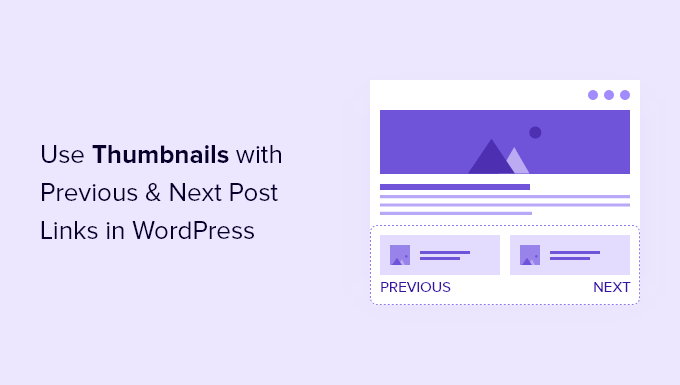
Why Display Thumbnails With the Previous and Next Post Links?
Your WordPress blog offers some helpful features to help your visitors find new content and navigate around your site.
These features include navigation menus, a search bar, and a post archives widget.
Another helpful navigation feature is found at the bottom of each WordPress blog post. There, you will find links to the previous and next blog posts on your site.
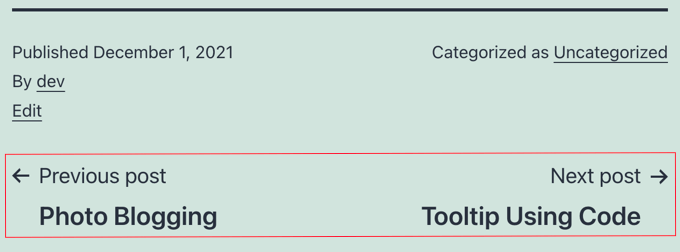
These links build user engagement because when your visitors finish reading one blog post, they will be looking for something else to read. However, the links will look more interactive if you add thumbnails.
It’s also a good way to bring attention to your best-performing blog posts. For example, you may have pillar content that is already driving a ton of traffic and converting those readers into email subscribers. Adding thumbnails with post links would only help you build your email list and grow your small business.
With that being said, let’s take a look at how to add thumbnails to the previous and next post links in WordPress.
Using Thumbnails with Previous and Next Post Links in WordPress
To add thumbnails to your previous and next post links, you’ll have to add code to your WordPress theme’s files. If you haven’t done this before, then see our guide on how to copy and paste code in WordPress.
Adding Code Using WPCode
The first step is to add the following code snippet with a plugin like WPCode.
WPCode is the best code snippets plugin that allows you to add code without breaking your site. It comes with plenty of ready-made templates as well, so you don’t have to write code from scratch.
To get started, you’ll need to install and activate the WPCode plugin. For more details, check out our article on how to install a WordPress plugin.
From there, go to the Code Snippets » + Code Snippets page. Then click on ‘Add New.’
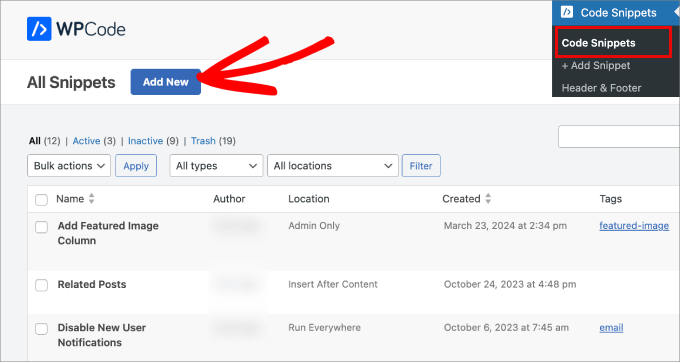
Here, you’ll be taken to a code snippet library where you can find tons of pre-made templates to choose from.
Under the ‘Add Your Custom Code,’ click on ‘Use Snippet.’
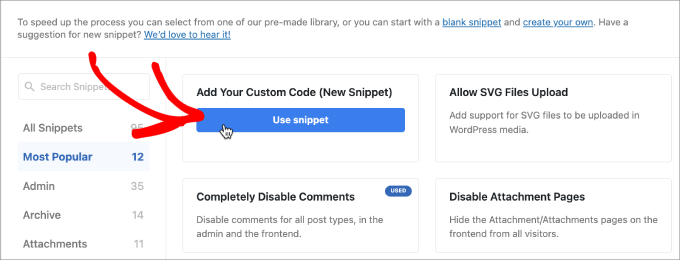
Give the code snippet a name so that you can refer back to it later.
Then, copy the following code into the WPCode text editor. Make sure to select ‘PHP Snippet’ as the Code Type.
function wpb_posts_nav(){
$next_post = get_next_post();
$prev_post = get_previous_post();
if ( $next_post || $prev_post ) : ?>
<div class="wpb-posts-nav">
<div>
<?php if ( ! empty( $prev_post ) ) : ?>
<a href="<?php echo get_permalink( $prev_post ); ?>">
<div>
<div class="wpb-posts-nav__thumbnail wpb-posts-nav__prev">
<?php echo get_the_post_thumbnail( $prev_post, [ 100, 100 ] ); ?>
</div>
</div>
<div>
<strong>
<svg viewBox="0 0 24 24" width="24" height="24"><path d="M13.775,18.707,8.482,13.414a2,2,0,0,1,0-2.828l5.293-5.293,1.414,1.414L9.9,12l5.293,5.293Z"/></svg>
<?php _e( 'Previous article', 'textdomain' ) ?>
</strong>
<h4><?php echo get_the_title( $prev_post ); ?></h4>
</div>
</a>
<?php endif; ?>
</div>
<div>
<?php if ( ! empty( $next_post ) ) : ?>
<a href="<?php echo get_permalink( $next_post ); ?>">
<div>
<strong>
<?php _e( 'Next article', 'textdomain' ) ?>
<svg viewBox="0 0 24 24" width="24" height="24"><path d="M10.811,18.707,9.4,17.293,14.689,12,9.4,6.707l1.415-1.414L16.1,10.586a2,2,0,0,1,0,2.828Z"/></svg>
</strong>
<h4><?php echo get_the_title( $next_post ); ?></h4>
</div>
<div>
<div class="wpb-posts-nav__thumbnail wpb-posts-nav__next">
<?php echo get_the_post_thumbnail( $next_post, [ 100, 100 ] ); ?>
</div>
</div>
</a>
<?php endif; ?>
</div>
</div> <!-- .wpb-posts-nav -->
<?php endif;
}
Next, toggle the button from ‘Inactive’ to ‘Active.’
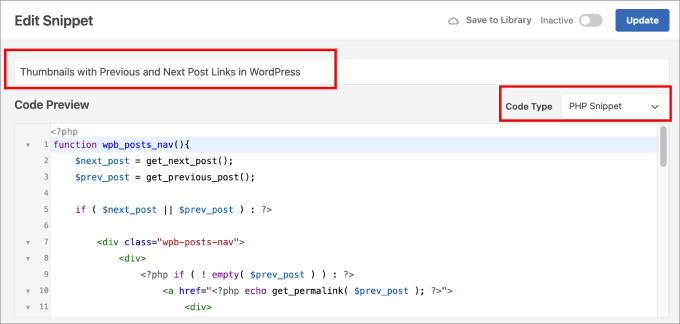
This will cause the code snippet take effect.
Then, you can simply hit the ‘Update’ button.
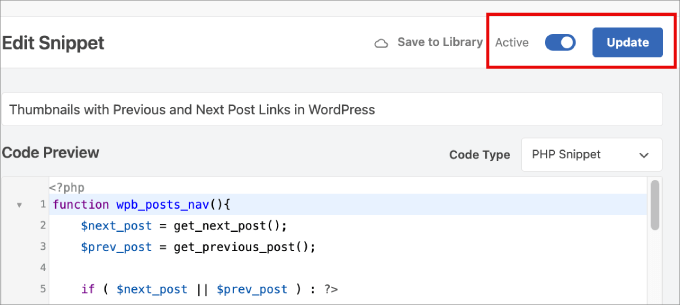
Now, we’ll need to go back to Code Snippets » +Add Snippet page.
Again, under the ‘Add Your Custom Code’ option, you’ll select ‘Use Snippet.’

Give the code snippet a name so that you can refer back to it later.
Then, copy the following code into the WPCode text editor. Make sure to select ‘PHP Snippet’ as the Code Type.
wpb_posts_nav();
This code tells WordPress where to show the navigation with the featured image.
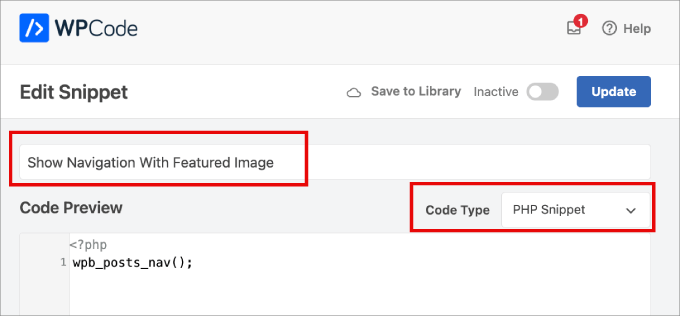
Next, scroll down to the Insertion section. You’ll need to click on the dropdown next to Location.
From here, go to Page-Specific and choose Insert After Post. That way, the thumbnails will appear properly next to the links.
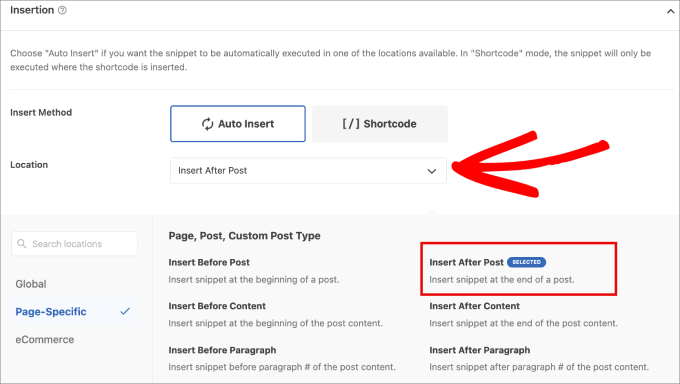
Finally, make the code snippet live by toggling the ‘Active’ button.
Then click ‘Update.’
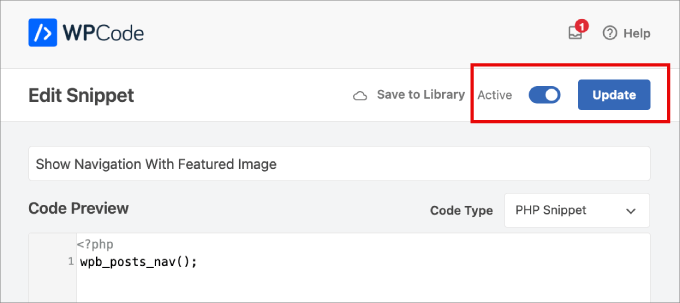
Once you save your changes, this function can be called from the template where you wish to display previous and next post links with thumbnails.
Now, when you view a post on your website, you will see that the previous and next links at the bottom of the post now have thumbnails.
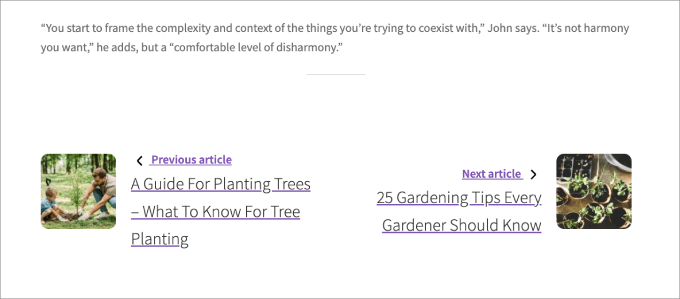
Now, when you view a post on your website, you will see that the previous and next links at the bottom of the post now have thumbnails.
Note: If one of the linked posts does not already have a featured image, then you will not see a thumbnail.
To learn how to add thumbnails to a post, see our guide on how to add featured images or post thumbnails in WordPress.
Alternative: Displaying Popular Posts with Thumbnails
Another way to engage your readers after they read a post is to display a list of popular posts after each article. This will give your readers a chance to see your best content rather than just the previous and next articles that were published.
Your popular posts contain your most successful content. Displaying them to your visitors will build trust, improve social proof, and ensure that your visitors stay on your website longer.
When you check the first method in our guide on how to display posts by views in WordPress, you’ll learn how easy it is to add popular posts using the MonsterInsights plugin.
MonsterInsights’ Popular Posts Widget offers a wide range of attractive themes and a lot of customization options.
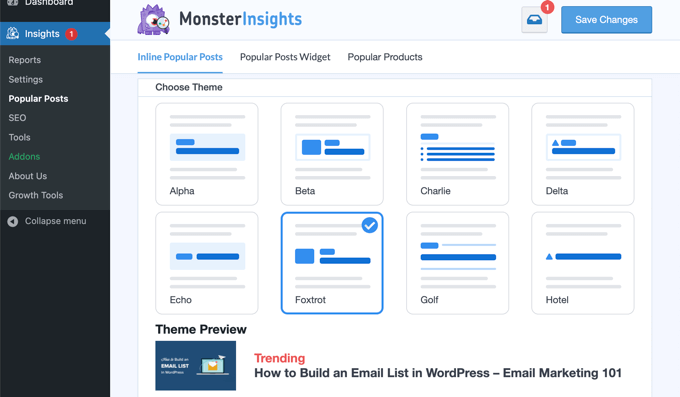
You may also want to see our guide on how to add custom after-post widgets in WordPress, where you can learn how to add various types of content to the end of each blog post.
We hope this tutorial helped you learn how to use thumbnails with previous and next post links in WordPress. You may also want to learn how to speed up WordPress performance or check out our list of the best social media plugins for WordPress.
If you liked this article, then please subscribe to our YouTube Channel for WordPress video tutorials. You can also find us on Twitter and Facebook.





Syed Balkhi says
Hey WPBeginner readers,
Did you know you can win exciting prizes by commenting on WPBeginner?
Every month, our top blog commenters will win HUGE rewards, including premium WordPress plugin licenses and cash prizes.
You can get more details about the contest from here.
Start sharing your thoughts below to stand a chance to win!
Atesz says
Hello,
thnak you for this code. I would like to add the post navigation in the middle of my page as a block. So I tried to create a shortcode calling the wpb_posts_nav funtion:
add_shortcode( ‘custom-post-nav’, ‘wpb_posts_nav’ );
but if I use the shortcode [custom-post-nav] in the block editor, I cannot publish the post and I get the following: “Updating failed. The response is not a valid JSON response”
The post nav still appears but only If I paste the code at the end of the page and then they go to wrong place (to the top).
Do you know where is the problem?
Thank you in advance!
WPBeginner Support says
For your JSON response error, we would recommend going through our troubleshooting guide below!
https://www.wpbeginner.com/wp-tutorials/how-to-fix-the-invalid-json-error-in-wordpress-beginners-guide/
Admin
Sekh Sahajahan says
Hello sir have you any solution to remove the 3 line navigation bar from menu bar because it automatically added.
Markus Martin says
Hi Syed. Does this still work especally with the new version of wordpress?
patricia says
Hello! How would I do, if i want to use this for custom post type? thanks
MarykeVanRensburg says
I got it to work. It seems the } in this “<?php } ?>” was the problem. I removed it and it works. Now just to figure out how to only show next and previous in same category. Thanks
bowetech says
HOw would i set it up so that it will actually get the next post from its current category ?
Japh says
Nice and simple solution, I really like it. Great answer for your Facebook asker
Wordpress Themes Labs says
nice guide
MarykeVanRensburg says
Can you tell me how to only show previous and next in the same category? Thanks for this code. I’m going to try it.
wpbeginner says
@MarykeVanRensburg I think the TRUE variable there means in category browsing.
MarykeVanRensburg says
@wpbeginner I used the code, but it doesn’t work in an Artisteer created theme. The code in my theme is as follows:
‘next_link’ => theme_get_previous_post_link(‘« %link’), ‘prev_link’ => theme_get_next_post_link(‘%link »’),
and I need to change it to show a thumbnail and only a certain category. Thanks.
wpbeginner says
@MarykeVanRensburg AFter the link area just add ,true
our code above will do only category browsing. Unfortunately we do not provide support for specific frameworks.
Sugeng Santoso says
I love this.
Dragon Blogger says
Really cool, I do think using thumbnails with latest/next post may be overkill if you already use it with “related posts” there is limited real estate which is especially true for the growing trend of mobile browsing.
wpbeginner says
@Dragon Blogger That is only if you are assuming that the site has related posts. Some may not. We are using it on our List25 site which is relatively new site, so related articles is not very helpful at the time. That is why we are using single post navigation.
Dragon Blogger says
@wpbeginner @Dragon Blogger
Dragon Blogger says
@wpbeginner your are right and make a good point about newer sites without enough content to do images for related content.